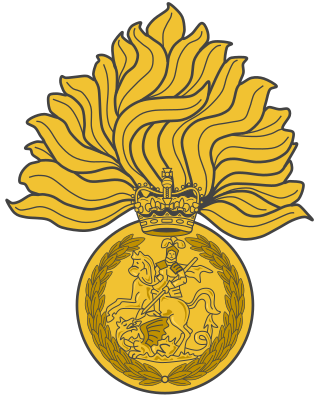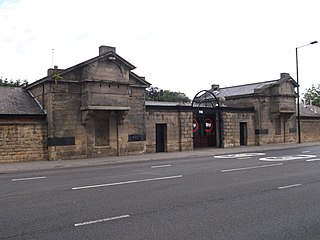
160th (Welsh) Brigade or Brigâd 160 (Cymru), is a regional brigade of the British Army that has been in existence since 1908, and saw service during both the First and the Second World Wars, as part of the 53rd (Welsh) Infantry Division. It is a regional command responsible for all of Wales. The Brigade is also regionally aligned with the Eastern European and Central Asian regions as part of defence engagement.

The Royal Regiment of Fusiliers is an infantry regiment of the British Army, part of the Queen's Division. Currently, the regiment has two battalions: the 1st Battalion, part of the Regular Army, is an armoured infantry battalion based in Tidworth, Wiltshire, and the 5th Battalion, part of the Army Reserve, recruits in the traditional fusilier recruiting areas across England. The Royal Regiment of Fusiliers was largely unaffected by the infantry reforms that were announced in December 2004, but under the Army 2020 reduction in the size of the Army, the 2nd Battalion was merged into the first in 2014.
The Tyne-Tees Regiment was a regiment of the British Territorial Army. The regiment was part of 15 Brigade and was the Territorial unit of infantry in the area stretching from Scarborough in North Yorkshire, to Alnwick in Northumberland.

The 52nd Lowland Volunteers is a battalion in the British Army's Army Reserve or reserve force in the Scottish Lowlands, forming the 6th Battalion of the Royal Regiment of Scotland, also known as 6 SCOTS. Due to its erstwhile association with the 1st Regiment of Foot, it is the senior Reserve line infantry battalion in the British Army. It is one of two Reserve battalions in the Royal Regiment of Scotland, along with 51st Highland, a similar unit located in the Scottish Highlands.

The Royal Northumberland Fusiliers was an infantry regiment of the British Army. Raised in 1674 as one of three 'English' units in the Dutch Anglo-Scots Brigade, it accompanied William III to England in the November 1688 Glorious Revolution and became part of the English establishment in 1689.
The 43rd Royal Tank Regiment was an armoured regiment of the British Army's Royal Armoured Corps that tested and demonstrated specialised Armoured Fighting Vehicles during World War II.

The Northumberland Hussars was a Yeomanry regiment of the British Army, transferred to the Royal Artillery for the duration of the Second World War. It was disbanded as an independent Territorial Army unit in 1967, a time when the strength of the Territorial Army was greatly reduced. The regiment's name lives on in the title of the command and support squadron of the Queen's Own Yeomanry (QOY), a Formation Reconnaissance Regiment based in Newcastle upon Tyne.
In September 1939, the British Army was in process of expanding their anti-aircraft and mobile assets. Among these new changes was the formation of Anti-Aircraft Command which was formed on 1 April 1939, and the 1st Armoured Division formed in 1937. The list below will include the British Army units, colonial units, and those units which were in the process of formation.
The Northumberland Brigade was formed in 1908 as part of the Territorial Force of the British Army with four battalions of the Northumberland Fusiliers. The brigade was numbered as 149th (Northumberland) Brigade in 1915 and served with the 50th (Northumbrian) Division on the Western Front throughout World War I. Due to losses suffered in the Ludendorf Offensive in 1918, it had to be comprehensively reorganized. Reformed as the Northumberland Brigade post-war, it was broken up before the outbreak of World War II.

Fenham Barracks is a military installation in Barrack Road, Newcastle upon Tyne, Tyne and Wear, England.
The Militia and Volunteers of Northumberland are those military units raised in the county independently of the regular Army. The "modern" militia dates from legislation enacted during the Seven Years' War. The volunteers had several forms and separate periods of existence until made a permanent body in 1859.

The Response 1914 is a war memorial in the public gardens to the north of the Church of St Thomas the Martyr in Barras Bridge, Newcastle upon Tyne, and to the west of Newcastle Civic Centre. Designed by Sir William Goscombe John, the memorial was commissioned by Sir George Renwick, 1st Baronet, and unveiled in 1923. It primarily commemorates the Territorial Army "Pals" battalions of the Northumberland Fusiliers raised by the local Chamber of Commerce in late 1914 for service in the First World War, which became known as the "Commercials". It also commemorates the safe return of Renwick's five sons from service in the war, and his 50 years in business as a ship-owner.

The Army Riding School was a military installation in Northumberland Road, Newcastle upon Tyne.

Dare Wilson Barracks, is a military installation in Hexham, Northumberland. The building is named after Major General Dare Wilson who was commissioned into the Royal Northumberland Fusiliers and commanded 22 Special Air Service Regiment in the early 1960s.

The 2nd Northumberland Rifle Volunteer Corps, also referred to as the Tynemouth Rifles, was an infantry unit of Britain's part-time force, the Territorial Army. The corps was raised during the expansion of the Volunteer movement in the 1850s and then served with the Territorial Force during the First World War. It converted to an anti-aircraft role just prior to Second World War, and continued to serve until it was amalgamated in 1950.
The Welsh Volunteers, was a short-lived Territorial Army infantry regiment of the British Army, that existed from 1967 to 1971.
The Northumbrian Volunteers was a short-lived Territorial Army infantry regiment of the British Army, in existence from 1971 to 1975.









